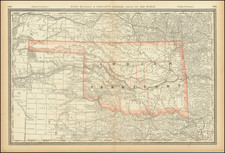Search
Between 1880 and 1900, Indian Territory witnessed a series of momentous events as the U.S. government opened up these lands to non-Indian settlers.
-
The most notable event was the Land Run of 1889, where the central portion of Indian Territory was opened for settlement. On April 22nd, 1889, over 50,000 people rushed into the region, staking claims on plots of land, an event that's now famously known as the 'Oklahoma Land Rush'.
-
Subsequent to the initial rush of 1889, there were several more land openings, such as the runs in 1891 and 1893, and the lottery of 1901. Each of these events saw vast tracts of tribal lands being appropriated for non-Indian settlers, radically transforming the demographics and socio-political structure of the region.
By 1900, the events depicted and foreshadowed by the 1891 map would lead to the eventual statehood of Oklahoma in 1907, marking the end of the unique Indian Territory era. The map thus stands not only as a geographical artifact but also as a chronicle of a transformative period in American history.
The map also shows Indian Territory following implementation of the allotment system. The allotment system in Indian Territory was a strategy employed by the U.S. government to distribute tribal communal lands to individual tribal members. This approach was grounded in the notion that private ownership would promote Native American assimilation into white American society.
Legislative Milestones:
-
1887: The General Allotment Act (Dawes Act) authorized the President to survey tribal lands and distribute them as individual allotments. Native American heads of households got 160 acres, single adults 80 acres, and children 40 acres. Surplus lands not allotted were sold to non-Native settlers.
-
1891: The Indian Appropriation Act furthered the allotment agenda by permitting the forced relocation of any tribe to Indian Territory.
-
1906: The Burke Act, amending the Dawes Act, extended the trust period indefinitely and granted the Secretary of the Interior the authority to bestow citizenship to "competent" individual Native Americans.
-
1934: The Indian Reorganization Act marked a shift, ending the allotment of tribal lands and promoting tribal self-governance.
Impact on Indian Territory:
-
Land Loss: Tribes lost about 90 million acres of their original land, nearly two-thirds of their original holdings.
-
Economic Decline: Dividing communal lands led many Native Americans into poverty as lands often received were unsuitable for farming.
-
Cultural Disruption: The policy undermined tribal governance and practices, aiming for assimilation into white American culture.
-
Population Movement: Selling surplus lands resulted in an influx of non-Native settlers, further displacing Native American populations.
In essence, the allotment system significantly altered the landscape of Indian Territory, leading to massive land loss, cultural erosion, and economic hardships for Native Americans.
Between 1880 and 1900, Indian Territory witnessed a series of momentous events as the U.S. government opened up these lands to non-Indian settlers.
-
The most notable event was the Land Run of 1889, where the central portion of Indian Territory was opened for settlement. On April 22nd, 1889, over 50,000 people rushed into the region, staking claims on plots of land, an event that's now famously known as the 'Oklahoma Land Rush'.
-
Subsequent to the initial rush of 1889, there were several more land openings, such as the runs in 1891 and 1893, and the lottery of 1901. Each of these events saw vast tracts of tribal lands being appropriated for non-Indian settlers, radically transforming the demographics and socio-political structure of the region.
By 1900, the events depicted and foreshadowed by the 1891 map would lead to the eventual statehood of Oklahoma in 1907, marking the end of the unique Indian Territory era. The map thus stands not only as a geographical artifact but also as a chronicle of a transformative period in American history.
The map also shows Indian Territory following implementation of the allotment system. The allotment system in Indian Territory was a strategy employed by the U.S. government to distribute tribal communal lands to individual tribal members. This approach was grounded in the notion that private ownership would promote Native American assimilation into white American society.
Legislative Milestones:
-
1887: The General Allotment Act (Dawes Act) authorized the President to survey tribal lands and distribute them as individual allotments. Native American heads of households got 160 acres, single adults 80 acres, and children 40 acres. Surplus lands not allotted were sold to non-Native settlers.
-
1891: The Indian Appropriation Act furthered the allotment agenda by permitting the forced relocation of any tribe to Indian Territory.
-
1906: The Burke Act, amending the Dawes Act, extended the trust period indefinitely and granted the Secretary of the Interior the authority to bestow citizenship to "competent" individual Native Americans.
-
1934: The Indian Reorganization Act marked a shift, ending the allotment of tribal lands and promoting tribal self-governance.
Impact on Indian Territory:
-
Land Loss: Tribes lost about 90 million acres of their original land, nearly two-thirds of their original holdings.
-
Economic Decline: Dividing communal lands led many Native Americans into poverty as lands often received were unsuitable for farming.
-
Cultural Disruption: The policy undermined tribal governance and practices, aiming for assimilation into white American culture.
-
Population Movement: Selling surplus lands resulted in an influx of non-Native settlers, further displacing Native American populations.
In essence, the allotment system significantly altered the landscape of Indian Territory, leading to massive land loss, cultural erosion, and economic hardships for Native Americans.

